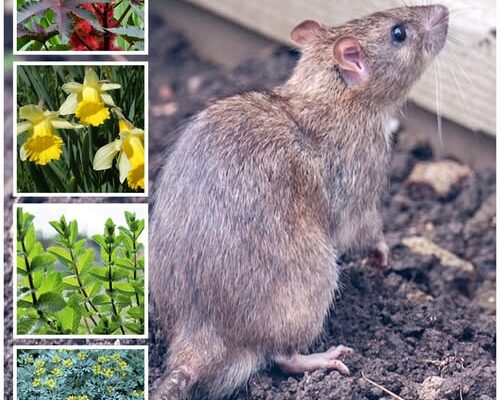Rats are dreaded pests in homes, as they can cause extensive material damage, spread disease and disrupt domestic tranquillity. While chemical raticides remain a common solution to control these intruders, they have many drawbacks: dangers for children, pets and the environment, as well as recurring costs. Fortunately, nature offers effective alternatives in the form of repellent plants that, thanks to their odorous or toxic properties, make it possible to repel rats that are safe for the ecosystem.
In this essay, we will explore how four plants – officinal street, peppermint, daffodil trumpet and castor – can be used to hunt rats naturally and sustainably. We will also see why these solutions are preferable to traditional methods, while highlighting their ecological and economic benefits.
1. The Officinal Street (Ruta graveolens): A Natural Weapons Against the Rats
Description and Properties
The officinal street, also called “fatty with cats”, is an aromatic plant known for its intense and particular smell. Although this odor is appreciated by some beneficial insects such as bees, it is highly unpleasant for rats and other rodents. The latter instinctively avoid the areas where the officinal street grows, which makes it a valuable ally in the fight against their infestation.
1.2 Conditions of cultivation
To grow the officinal street successfully, choose a sunny location in your garden. This plant likes well-drained soils but requires regular irrigation to grow properly. Here are some practical tips:
- Arrosage Watering: Make sure the soil remains constantly moist without ever being saturated. You can check the soil moisture by inserting a dry stick: if it comes out clean and slightly moist, it is perfect.
- Entretien Maintenance: Cut the plant as needed to promote dense and compact growth. It will also enable it to produce more essential oils that are responsible for its repellent odour.
1.3 Benefits
The use of officinal street has several advantages:
- Écologique Ecological: By opting for this method, you eliminate any potentially dangerous chemical.
- Easy to maintain: This plant is robust and adapts well to varied climates.
- Additional protection: In addition to its repellent effects on rats, the officinal street attracts pollinating insects and may even deter certain parasites such as fleas or mosquitoes.
2. The Pepper Mint (Mentha x piperita): A Gourmet and Rutting Ally
2.1 Characteristics and use
Peppermint is a very popular aromatic plant, not only for its culinary virtues but also for its repellent properties against rodents. Rats have extreme olfactory sensitivity, and the mentholated odour of peppermint is particularly unbearable. In addition, this plant is easy to grow and can be used in many ways.
2.2. Cultivation mode
Peppermint thrives in a partially shaded and fresh environment. Here are some recommendations for his culture:
- Plantation: Simmer it in spring in rich and well-drained soil. Prefer a container if you are afraid that it will proliferate too quickly.
- Annual size: In the autumn, trim the plant to encourage a further vigorous flare-up in the following spring.
- Multiplication Multiplication: Peppermint spreads easily through cutting, allowing a quick-release plant barrier around your home.
2.3 Practical applications
In addition to direct planting in the garden, you can use peppermint in different forms:
- Essential oil: Apply a few drops of peppermint oil to cotton balls placed near the potential entry points of the rats (such as windows or doors).
- Infusion Infusion: Prepare a strong infusion from fresh leaves and spray it into the strategic corners of your home.
In addition to protecting your home, peppermint will enrich your meals and drinks, offering a double advantage.
3. 3. The Jonami Trompette (Narcissus pseudonarcissus): Anti-Rats Floral Decoration
3.1 Natural assets
The daffodil trumpet, with its bright yellow flowers, is not only a magnificent ornamental plant but also a natural repellent against rats. The latter instinctively avoid narcissu bulbs, as they contain toxic substances that can be harmful to them. Moreover, the roots of these plants secrete chemical compounds that signal to rodents that the place is not safe.
3.2 Maintenance and planting
To take full advantage of the benefits of the daffodil trumpet, follow these steps:
- Installation Installation: Plant the bulbs in the autumn in a cool, shaded place. They will usually flower in early spring.
- Hydratation Hydration: Keep a constant humidity by placing a plate of water under the pots during the winter, especially if you grow these flowers indoors.
- Surveillance Surveillance: Check regularly that the bulbs are not attacked by fungi or diseases.
3.3 Impact Aesthetics
In addition to its repulsive properties, the dial trumpet embellishes your exterior with its bright colors and abundant flowering. It can be planted around your house to form a visual barrier while discouraging rats from approaching
4. Ricin (Ricinus communis): A Powerful and Multi-purpose Solution
4.1 History and toxicity
Castor is a tropical plant native to East Africa, widespread today in gardens around the world. Its seeds contain a toxin called ricin, which is extremely dangerous for rodents (and humans so ingested). Although this toxicity should be handled with caution, it is a formidable way to deter rats.
4.2 Cultivating the Ricin
Here are some tips for planting and maintaining castors:
- Ideal season: Sow the seeds in early spring in soil exposed to the sun.
- Wind protection: Place protections around the seedlings to prevent them from being damaged by gusts.
- Récolte Harvesting: Soft shoots can be dried and processed into infusion to create a natural spray against rats.
4.3 Precautions
Although castor is an excellent repellent, certain precautions should be taken:
- Never eat its seeds or edible parts.
- Keep plants out of the reach of children and pets.
- Wear gloves when handling seeds or leaves.
Despite these constraints, castor remains an effective option for those who wish to adopt a natural approach against rats.
5. Why prefer natural solutions?
5.1 Respect for the environment
Chemical raticides pose serious environmental problems. Not only do they kill rats, but they can also affect natural predators like birds or cats that eat intoxicated rodents. On the other hand, repellent plants act only as a deterrent system, thus preserving the balance of the local food chain.
5.2 Economy
Chemicals against rats are often expensive in the long term, especially if infestation persists. Plants, on the other hand, are a cost-effective solution since you can multiply them free of charge via cuttings or seedlings. Once installed, they continue to work for several years without the need for constant renewal.
5.3 Health and safety
Conventional pesticides may pose risks to human health, especially when handled incorrectly. Plants, for their part, are generally safe for the occupants of the fireplace, provided that they comply with the specific safety rules (as for castors).
6. Combination of plants: A Global Strategy
To maximize the effectiveness of your natural defense against rats, consider combining multiple repellent plants. For example:
- Plant off the officinal street near the exterior openings.
- Place pots of peppermint in the living rooms.
- Integrate dock trumpets into your floral massifs.
- Cultivate castor in the more remote areas of your garden.
This diversification creates a real multisensory barrier that will make your habitat unattractive for rats.
7. Other complementary methods
Although plants are an effective solution, they work even better when combined with other prevention practices:
- Regular cleaning: Dispose of all sources of food accessible to rats (milies, organic waste).
- Cut-off of holes: Identify and close the possible entry points into your home.
- Safe storage: Keep food in hermetically sealed containers to avoid attracting rodents.
8. Conclusion: Towards Harmonious Coexistence
Repellent plants against rats offer an environmentally friendly and accessible alternative to all. Whether it is officinal street, peppermint, daffodil trumpet or castor, each of these plants brings unique practical and aesthetic benefits. By integrating these natural solutions into your daily life, you are helping to reduce your ecological footprint while protecting your family and home.
So why not give these powerful plants a chance? With a little patience and care, they will transform your space into a hostile area for rats, while embellishing your environment. Don’t wait any longer to make your home safer and greener. – –



